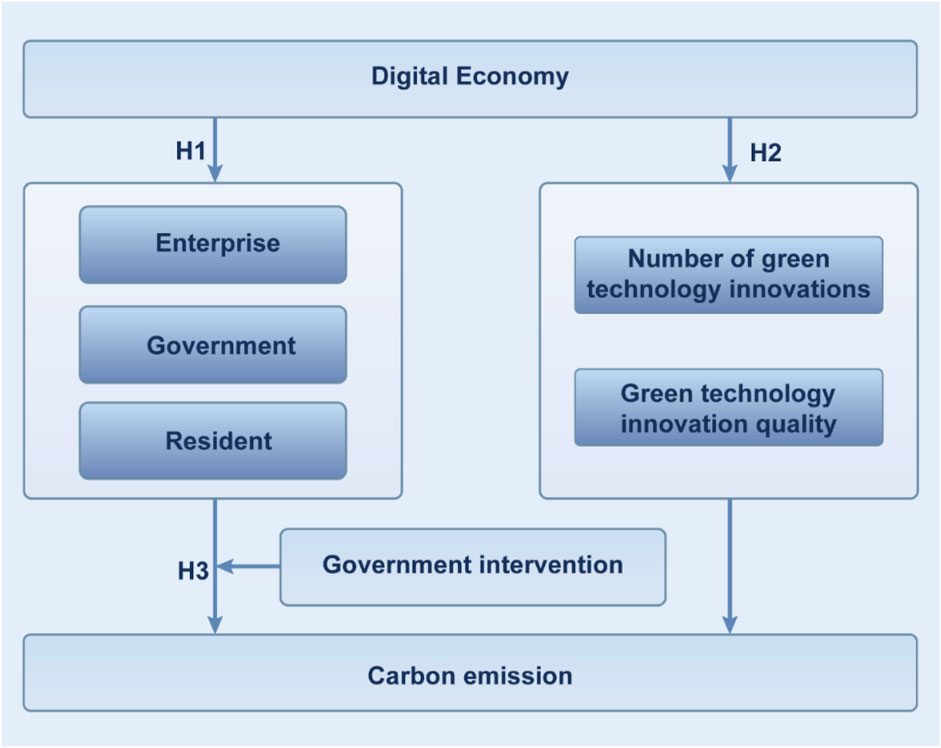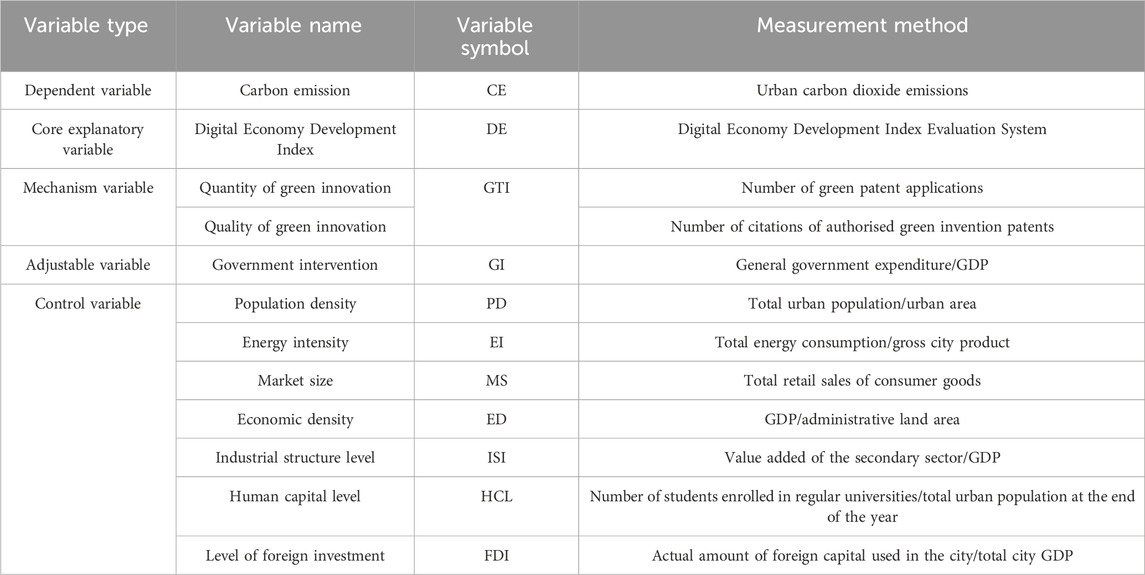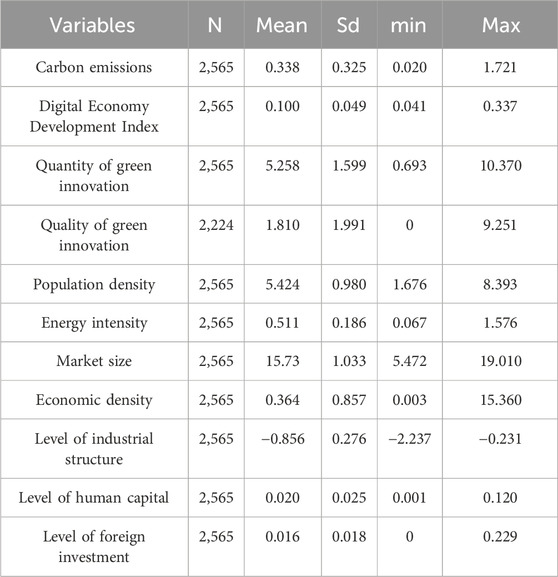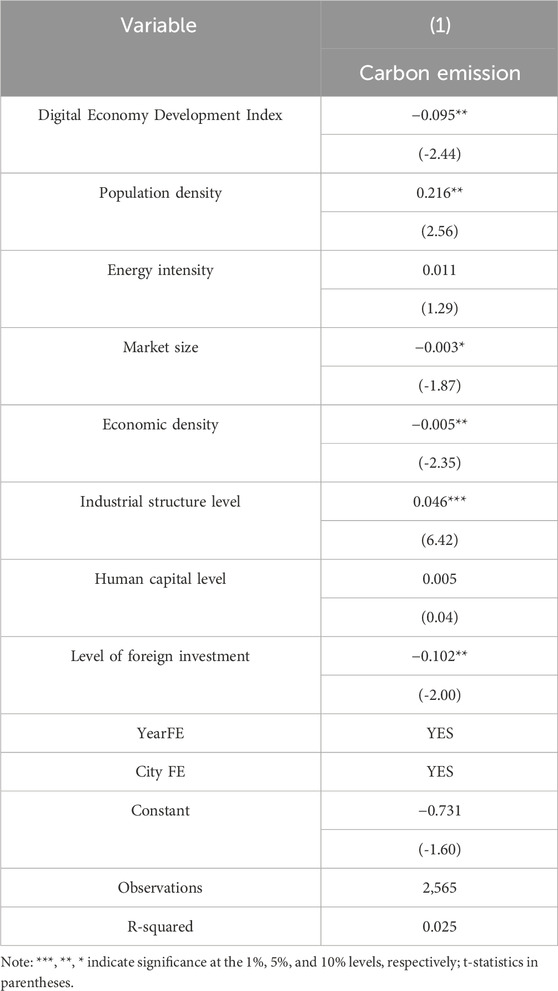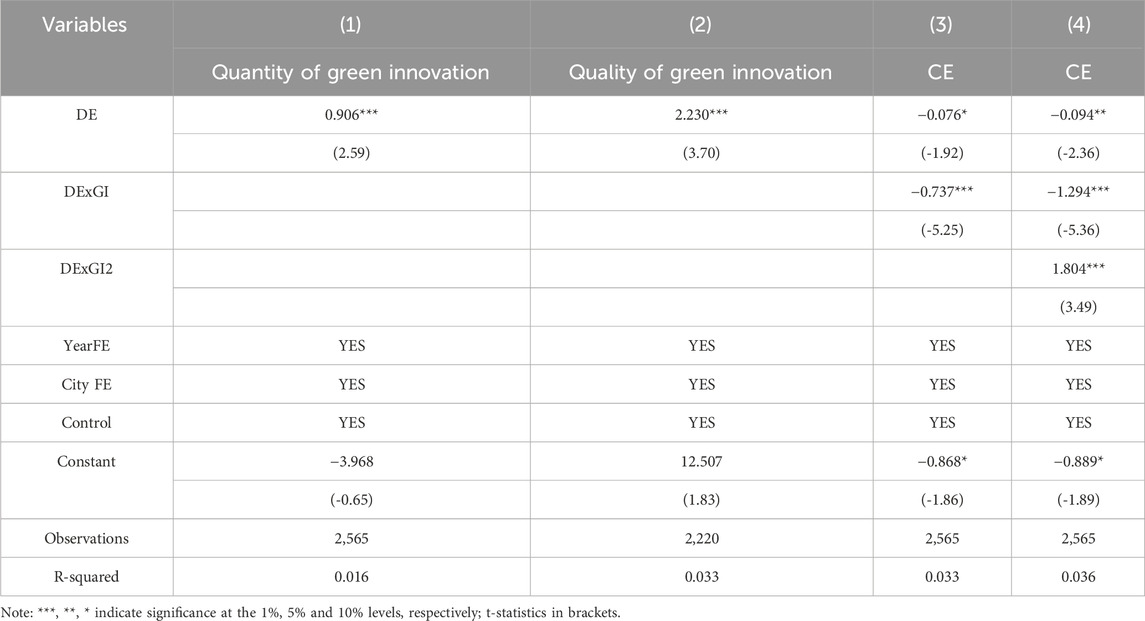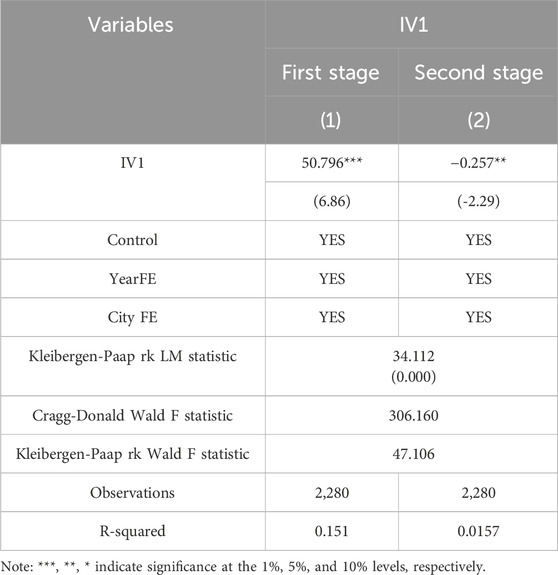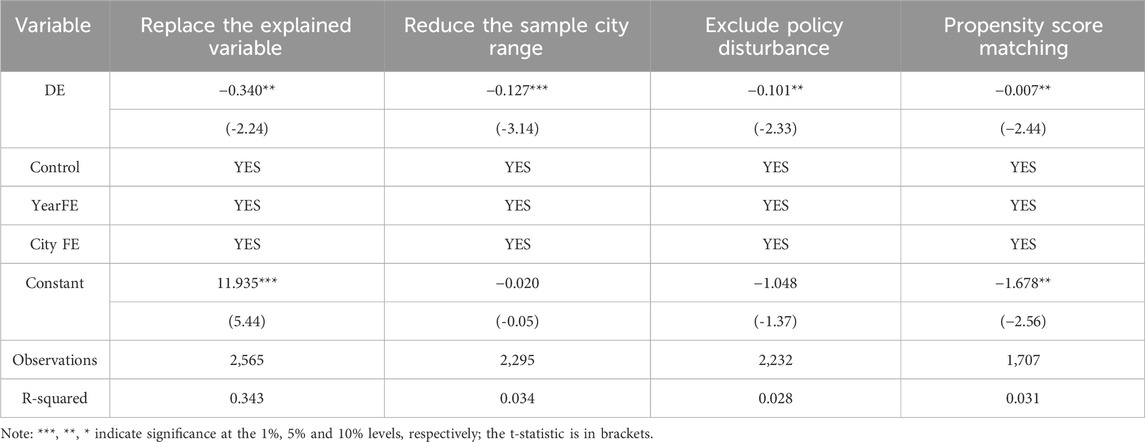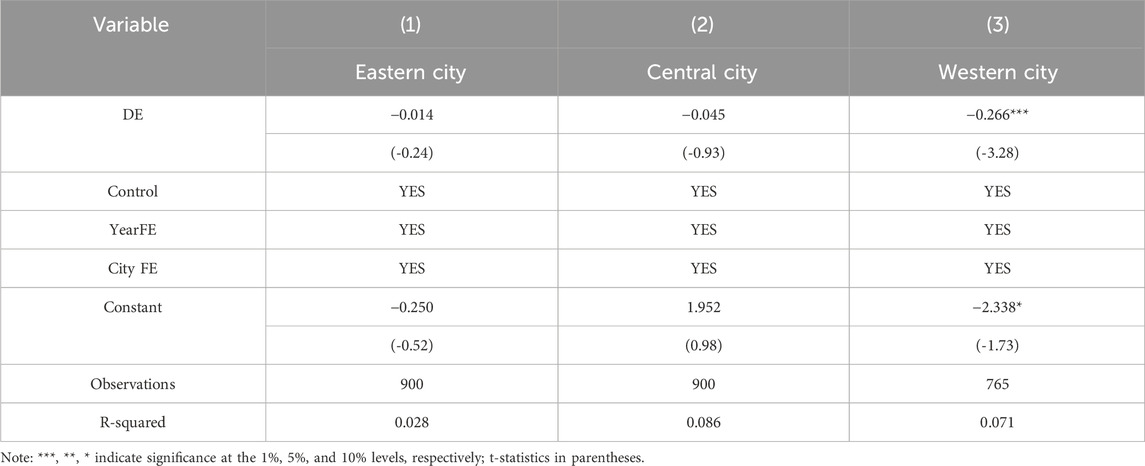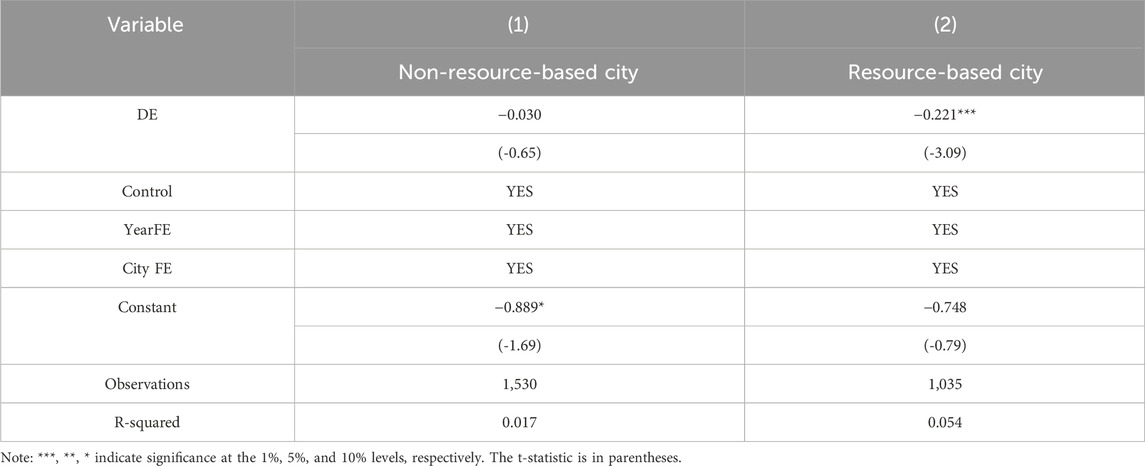- School of Economics, Management and Law, University of South China, Hengyang, China
While the digital economy offers a potential pathway toward a low-carbon transition, its net effect on carbon emissions is theoretically ambiguous and the underlying mechanisms remain underexplored. This study investigates the impact of the digital economy on urban carbon emissions by developing a more comprehensive analytical framework that distinguishes between the quantity and quality of green technological innovation as mediating pathways and considers the nonlinear moderating role of government intervention. Using panel data from 285 Chinese cities from 2013 to 2021, we find that the digital economy significantly curbs urban carbon emissions. This effect is mediated by both the quantity and quality of green technological innovation. Crucially, government intervention exhibits a nonlinear, ‘inverted U-shaped’ moderating effect, whereby it initially enhances the digital economy’s emission reduction impact before attenuating it at higher levels of intervention. Further, a heterogeneity analysis reveals that the emission reduction effect is more pronounced in western regions and resource-based cities. Our findings clarify the complex channels linking digitalization to decarbonization and highlight the critical need for carefully calibrated government policies to maximize the environmental benefits of the digital economy.
1 Introduction
The rapid expansion of the digital economy presents both significant opportunities and complex challenges for the global low-carbon transition. On one hand, digital technologies can enhance energy efficiency, optimize industrial structures, and foster sustainable business models (Bai et al., 2019; Ghasemaghaei and Calic, 2019), thereby serving as a potential catalyst for carbon emission reduction. On the other hand, the proliferation of digital infrastructure and data-driven processes increases electricity consumption, while potential rebound effects from efficiency gains may lead to a net rise in carbon emissions (Ren et al., 2021). This ambiguity has sparked a considerable academic debate on the net environmental impact of digitalization.
At the theoretical level, empirical evidence on the relationship between the digital economy and carbon emissions is divided, yielding three competing perspectives. The first argues that digitalization exacerbates carbon emissions due to increased energy consumption (Ma et al., 2022; Salahuddin et al., 2018) and rebound effects (Lange et al., 2020; Wang et al., 2019). For instance, a study of 76 emerging economies found that growth in digital financial inclusion was positively correlated with carbon emissions (Khan et al., 2023). The second perspective highlights the mitigating impact of the digital economy, suggesting that digitally driven technological progress and integrated environmental management can effectively lower emissions (Zhou and Chu, 2025; Hu, 2023). The third perspective contends that the relationship is nonlinear, often following an inverted U-shaped or U-shaped trajectory depending on the stage of development and regional context (Li and Wang, 2022; Du et al., 2025; Xie et al., 2024).
Although the relationship between the digital economy and carbon emissions has been richly explored, resolving these conflicting findings requires a deeper investigation of the underlying causal mechanisms. The literature exhibits two primary shortcomings. First, existing studies tend to treat green technological innovation as a monolithic concept. This overlooks the critical distinction between innovation quantity and quality, potentially mischaracterizing the true impact of the digital economy. Second, the role of government intervention is often simplified to a linear effect, ignoring the possibility that its influence may be nonlinear. The intensity of government intervention could have varying impacts at different stages, a complexity that remains underexplored.
This paper addresses these gaps using panel data from 285 prefecture-level cities in China from 2013 to 2021. Our contributions are threefold. First, we disentangle the mediating effect of green technological innovation by separately examining its quantity and quality, offering a more nuanced understanding of the innovation channel. Second, we introduce government intervention as a moderator and, for the first time, systematically test for a nonlinear, ‘inverted U-shaped’ relationship, providing a critical empirical basis for designing effective policies. Finally, we construct a more robust measure of green innovation quality using enterprise-level patent citation data, overcoming the limitations of simple patent counts and more accurately capturing knowledge diffusion and impact.
2 Literature review and hypothesis development
2.1 Digital economy and carbon reduction
First, the digital economy promotes carbon reduction by driving the transformation of enterprise production models. Digitalization steers companies toward high value-added, low energy-intensive sectors, effectively curbing excessive consumption of energy and resources (Liu et al., 2024; Shang et al., 2023). Digital technologies also enable firms to continuously monitor and optimize production and logistics processes in real time, substantially enhancing energy efficiency and reducing unnecessary energy consumption (Huang and Lin, 2024; Wang and Shao, 2023). For example, the use of demand forecasting and scheduling based on big data can significantly minimize redundant equipment operation and material wastage. In addition, the collaborative enterprise network built on intelligent manufacturing platforms eliminate informational silos between departments and regions, facilitates efficient cross-organizational collaboration, and lowers overall carbon intensity.
Second, digital economy enhances environmental governance capacity, providing robust technical support for targeted emission reductions (Liao and Liu, 2024). By harnessing technologies such as the Internet of Things and big data, regulatory bodies can continuously track energy consumption and emission levels across industries, allowing for prompt warnings and timely corrective measures when irregularities occur (Zou et al., 2024). This highly precise and dynamic supervision model not only ensures regulatory compliance while providing a credible and timely basis for informed policy decisions on instruments such as tiered carbon taxes, emissions trading, and subsidies. This data-driven approach allows governments to formulate and adjust emission reduction targets and supporting measures with greater precision.
Third, the iterative development of the digital economy is profoundly shaping consumer perceptions and behavioral preferences (Wang and Li, 2024). Thanks to the rapid dissemination of market information and the optimization of consumer feedback mechanisms by digital platforms, public awareness and sensitivity to knowledge related to energy conservation and emission reduction is continuously increasing, facilitating greater acceptance of clean energy adoption and low-carbon consumption behaviors. At the same time, the application of digital technology in the sharing economy, online transactions, and service innovation has not only strengthened residents’ awareness of the feasibility of low-carbon practices but also encouraged concrete environmental actions in daily life, thereby driving a fundamental shift toward widespread green lifestyle adoption (Jiang et al., 2024).
Collectively, these mechanisms on the production, governance, and consumption sides suggest that the digital economy has a net negative effect on carbon emissions. Therefore, we propose the following hypothesis:
H1:. The digital economy helps to curb carbon emissions.
2.2 Intermediary effect: digital economy, green technological innovation and carbon emission reduction
The digital economy stimulates both the quantity and quality of green technological innovation through several mechanisms (Zhang et al., 2024; Zhao et al., 2023; Lin and Ma, 2022; Hu et al., 2024). Regarding innovation quantity, digitalization lowers the barriers to entry for R&D. It broadens financing channels and mitigates investment risks through more efficient, data-driven credit markets (Demertzis et al., 2018). Furthermore, the continuous advancement of digital infrastructure, such as ‘pay-as-you-go’ cloud computing, significantly lowers the marginal cost of research, enabling broader participation in green innovation (Avram, 2014). Regarding innovation quality, digital platforms and collaboration tools overcome spatial barriers, fostering knowledge spillovers and cross-domain synergies that accelerate the development of high-impact technologies (Del Giudice et al., 2019). Digital technologies also enable the seamless integration of diverse data, while advanced algorithms and big data analytics allow for the precise identification of key technological opportunities and the optimization of R&D processes, thereby enhancing the overall quality and impact of green patents (Han et al., 2024).
Green technological innovation is strategically vital for transitioning the economy toward a low-carbon model and achieving carbon reduction goals (Habiba et al., 2022). Its influence extends to both energy supply and industrial processes. On one hand, the broad adoption of advanced renewable energy technologies—such as solar, wind, and biomass—has been instrumental in the energy transition, significantly increasing the proportion of clean energy in the overall energy structure. Furthermore, the integration of efficient energy storage systems and smart grids stabilizes the fluctuations inherent in intermittent renewable energy sources and facilitates the seamless integration of renewables into the grid. This shift is gradually replacing traditional fossil fuel generation, leading to substantial reductions in carbon emissions at the macro level (Panwar et al., 2011; Suberu et al., 2014).
On the other hand, green technological innovation plays an essential role in optimizing product design and production processes. The introduction of eco-design concepts allows products to be designed with easy recycling and remanufacturing features from the early stages, thereby extending the product life cycle and reducing dependence on virgin resources while minimizing the environmental impact of resource extraction and processing (Tseng et al., 2013). This, in turn, lowers energy consumption and carbon emissions throughout the production cycle. Simultaneously, the adoption of advanced energy-saving and emission-reduction equipment, together with automated control technologies, has facilitated low-carbon production processes, enhanced resource efficiency, and provided strong technical support for the transition to a circular economy (Xie et al., 2023; Giannetti et al., 2020).
By stimulating both the quantity and quality of green technological innovation, which in turn provides the critical tools for decarbonizing energy supply and industrial production, the digital economy can effectively curb carbon emissions. Based on this two-step logic, we propose the following hypothesis:
H2:. The digital economy effectively curbs carbon emissions by driving both the quantitative and qualitative advancement of green technological innovation.
2.3 Regulatory effects: digital economy, government intervention and carbon emission reductions
The efficacy of the digital economy in facilitating a low-carbon transition depends critically on the institutional context, where government intervention plays a crucial moderating role. From an institutional perspective, moderate government intervention can amplify the digital economy’s emission reduction effects. According to the theories of new institutional economics and institutional change, modifications in formal institutions represent endogenous adjustments made by governments in response to changes in the external environment and internal technological evolution. Against the dual backdrop of the rapid growth of the digital economy and intensifying climate change pressures, they internalize the negative externalities of carbon emissions into corporate costs through mechanisms like environmental regulations and green incentives (Yang et al., 2021; Shao and Chen, 2022).
Furthermore, governmental implementation of strategic digital infrastructure projects, investments in scientific and technological R&D, and the creation of cross-sector collaborative innovation platforms and information-sharing mechanisms have effectively mitigated innovation risks associated with the cross-industry application of digital low-carbon technologies. These efforts have accelerated the diffusion of digital technologies, significantly enhancing their contribution to carbon emission reductions (Peng et al., 2024). Therefore, at moderate levels, government intervention effectively rectifies market failures and technology diffusion barriers, substantially enhancing the capacity of the digital economy to reduce carbon emissions.
However, the benefits of government intervention are likely non-monotonic. Drawing on theories of rent-seeking and regulatory capture, excessive intervention intensity or inadequate regulatory mechanisms may trigger rent-seeking and regulatory capture behaviors, thereby weakening policy incentives (Wang et al., 2023). Moreover, enterprises may progressively capture policymakers through prolonged lobbying activities and by exploiting information asymmetry advantages, causing policy orientation to deviate from the public interest toward specific interest groups. This shift can distort competition, reduce resource allocation efficiency within the digital economy sector, and substantially weaken its carbon emission reduction effectiveness (Yuan, 2021). This can distort competition and substantially weaken the digital economy’s carbon reduction effectiveness.
This two-sided effect implies that the moderating influence of government intervention is not linear. Instead, its strengthening effect on carbon reduction likely increases at first but then diminishes as intervention becomes excessive. This suggests an inverted U-shaped relationship.
H3:. Government intervention positively moderates the impact of the digital economy on carbon emissions, exhibiting a U-shaped moderating effect. Based on the above analysis, the theoretical logic of this paper is illustrated in Figure 1.
3 Research design
3.1 Variable measurement and description
3.1.1 Dependent variable
The dependent variable in this study is carbon emission levels (CE), carbon emission data for Chinese cities is obtained from the EDGAR database (Dong et al., 2022). The emissions accounting scope encompasses not only energy-related activities but also industrial processes, non-energy use emissions, and spontaneous fuel combustion, ensuring a more comprehensive assessment. The original 0.1 ° × 0.1 ° spatial grid data is processed and aggregated to the city level using ArcGIS 10.8 for spatial matching.
3.1.2 Core explanatory variable
The core explanatory variable is the Digital Economy Development Index (DE). Given the limited literature on city-level digital economy measurement, this study evaluates the digital economy across five key dimensions (Tao et al., 2022). The index is constructed using the entropy method with objective weighting to ensure robustness. The specific indicators used for measurement are detailed in Table 1.
3.1.3 Mechanism variable
Green innovation comprises two primary dimensions: innovation inputs and innovation outputs. Innovation inputs are typically measured by R&D expenditures or the number of R&D personnel, whereas innovation outputs are commonly evaluated based on the number of new products, revenue generated from new product sales, or patent counts. However, due to the inherent uncertainty and risk associated with R&D activities, and considering that new product launches are frequently influenced by multiple factors, including market strategies, brand influence, and external environmental conditions, patents are recognized as a relatively stable indicator for assessing green innovation (Berrone et al., 2013).
Consequently, adopting a patent-based perspective, this study utilizes the number of green patent applications as a quantitative indicator to measure the scale of urban green innovation activities (Cai et al., 2020). In terms of innovation quality, the number of citations of authorized green invention patents is selected as the core evaluation criterion. This choice is made because R&D activities related to green innovation inherently involve high uncertainty and risk, and the market performance of new products or technologies is significantly affected by brand influence, marketing strategies, and external environmental factors, resulting in substantial volatility of relevant economic indicators. In contrast, the number of patent citations provides a more stable and objective reflection of the intrinsic value and actual industry impact of technological innovation (Hall et al., 2000; Wang et al., 2013). Therefore, to comprehensively evaluate the quality of green patents, this study retrieves citation data for authorized green invention patents at the enterprise level from the CNRDS database and matches these data to the corresponding cities. This matching allows the construction of a city-level indicator reflecting the number of citations of authorized green patents, facilitating a comprehensive assessment of green patent quality.
3.1.4 Control variable
To eliminate confounding effects, reduce bias, and enhance model interpretability, this study incorporates several control variables based on existing literature. For instance, economic growth often exhibits a nonlinear relationship with emissions, as described by the Environmental Kuznets Curve (Grossman and Krueger, 1995), while improvements in energy efficiency are recognized as a critical mitigation strategy (Akram et al., 2020). Furthermore, foreign investment can also influence regional emissions, with its effect often conditioned by local human capital levels (Lan et al., 2012). Building on this established literature, this study specifically includes the following variables: population density (Wang and Li, 2021), energy intensity (Tao et al., 2024), consumption scale (Liu et al., 2021), economic density (Xia et al., 2023), industrial structure level (Su et al., 2018), human capital level (Haini, 2021), and foreign investment level (Pan et al., 2023). A detailed description of these variables is provided in Table 2.
3.1.5 Sample selection and data sources
This study selects the 2013–2021 time interval, as China has introduced several key policies on the digital economy and environmental protection since 2013, fostering significant advancements in both domains. However, due to data limitations and the unavailability of certain variables in later years, the digital economy indicators used in this study are only available up to 2021. To ensure data reliability, cities with high missing data rates or those that underwent administrative division adjustments were excluded. Ultimately, 285 cities were selected, yielding 2,565 valid observations. The descriptive statistics are presented in Table 3. The carbon emissions data used in this study is sourced from the EDGAR database. Indicators of digital economy development are obtained from the China Regional Economic Database and the China City Database. Data on green technological innovation originates from the China Statistics Bureau and the China Research Data Service Platform (CNRDS). Meanwhile, data for the remaining control variables is collected from sources such as the China City Statistical Yearbook and LandScan.
3.2 Model construction
3.2.1 Baseline regression model setting
The core issue of this paper is to explore the impact of the digital economy on carbon emissions, so a benchmark regression model is constructed.
Where,
3.2.2 Mechanism test model
To investigate the impact mechanism of the digital economy on green technological innovation—and to circumvent endogeneity issues associated with stepwise methods that might compromise the reliability of our findings—this paper develops a model based on existing research, as shown in Equation 2, to examine whether green technological innovation serves as a mediator between the digital economy and carbon emissions (Jiang, 2022):
Among them,
3.2.3 Adjustment effect test model
This study uses government intervention as a moderating variable. The degree of government intervention is measured by general government expenditure/GDP (Yang et al., 2023), and is expressed as GI. The higher the value, the higher the degree of government intervention. Model 3 is constructed in this paper (as shown in Equation 3) to test the moderating effect of government intervention. In this model, the focus is on the interaction term (
In order to test whether government intervention has a nonlinear regulatory effect on the impact of the digital economy on carbon emissions, this paper adds the squared term of government intervention (
4 Empirical results and analysis
4.1 Benchmark regression
Table 4 demonstrates that the impact of the digital economy on carbon emissions is both negative and statistically significant at the 5% level. This result indicates that, holding other factors constant, a higher level of digital economic development is associated with a significant reduction in urban carbon emissions, providing strong empirical support for H1 It implies that the digital economy acts as a powerful enabler of sustainability transitions by simultaneously driving the digital transformation of enterprises to enhance energy efficiency on the production side, facilitating more precise, data-driven environmental governance on the regulatory side, and fostering greener consumption patterns on the demand side.
4.2 Mechanism test
4.2.1 Effect of green technological innovation
Theoretical analysis suggests that the digital economy reduces carbon emissions by driving green technological innovation. Furthermore, does the digital economy also directly influence green innovation itself? This study addresses this question by examining two key dimensions: the quantity and quality of green technological innovation.
(1) The digital economy has significantly increased the number of green technological innovations. Its internal mechanisms are as follows: first, the widespread adoption of digital information networks enables research institutions and enterprises to rapidly and cost-effectively access the latest global green technology information and market demand trends. This effectively reduces redundant research efforts, lowers technological innovation risks and barriers to entry, and encourages more entities to actively apply for green patents. Second, the use of digital collaboration platforms (e.g., GitHub, Zoom) has significantly enhanced the efficient transfer of knowledge and resources among enterprises, universities, and research institutes, fostering deeper cross-regional and interdisciplinary collaboration. This approach transcends spatial and temporal limitations, shortens the R&D transformation cycle, and further increases the activity level and volume of green technological innovations.
(2) The digital economy has also significantly enhanced the quality of green technological innovations. Specifically, intelligent patent searches, patent mapping, and trend analysis tools based on big data and artificial intelligence enable R&D entities to precisely identify critical technological bottlenecks and promising innovation pathways in the field of green technology. This reduces inefficient and redundant R&D investments, enhancing the differentiation and technological novelty of newly filed patents. Moreover, the adoption of digital tools such as industrial Internet and digital twin technologies has significantly shortened technology development and experimental verification cycles, improved design precision and application stability throughout the R&D process, and effectively reduced innovation failure risks. Additionally, the immediacy and extensive reach of digital networks enable authorized high-value green patents to be rapidly and widely cited, facilitating swift knowledge feedback and rapid technological iteration. This dynamic continuously improves the overall quality of green innovation outputs, promotes large-scale adoption of green technologies, and accelerates the low-carbon economic transition.
Existing studies widely acknowledge the role of green technological innovation in reducing carbon emissions (Sharif et al., 2022; Ren et al., 2022). Following the mechanism testing approach proposed by Jiang Ting, if the digital economy significantly drives green technological innovation, it indirectly confirms that green innovation serves as a key transmission channel through which the digital economy facilitates carbon emission reduction. As shown in Table 5, the digital economy positively influences both the quantity and quality of green technological innovation. This evidence substantiates the conclusion that the digital economy effectively promotes green technological innovation, thereby contributing to carbon emission reduction and verifying Hypothesis 2.
4.2.2 The moderating effect of government intervention
Table 5, column (5), shows that the interaction term between the digital economy and government intervention is −0.737, which is statistically significant at the 1% level. This finding suggests that as government intervention increases, the negative impact of the digital economy on carbon emissions is amplified—indicating a positive moderating effect of government intervention on this relationship. In column (6), the coefficient for DExGI is −1.294 (significant at the 1% level), while the coefficient for DExGI2 is 1.804 (also significant at the 1% level). These results confirm a U-shaped moderating effect, further reinforcing the notion that government intervention significantly influences the digital economy’s capacity to reduce carbon emissions. H3 is thus validated, highlighting that insufficient government intervention—whether in fiscal expenditure or administrative oversight—fails to provide enterprises with the necessary institutional environment and infrastructure, thereby constraining the digital economy’s potential to mitigate carbon emissions. Conversely, excessive administrative intervention and financial expenditure may lead to resource misallocation, ultimately diminishing the carbon reduction efficiency of the digital economy. Therefore, governments should adopt a balanced approach that integrates targeted financial investment with prudent administrative oversight. By ensuring that the digital economy receives essential institutional support and infrastructure development—while mitigating the risks associated with excessive intervention—policymakers can optimize its role in carbon emission reduction.
4.3 Endogeneity test
To address potential endogeneity concerns, this study employs an instrumental variable (IV) strategy following prior research (Bartik, 2009; Yi and Zhou, 2018). Specifically, we construct an instrumental variable by interacting the one-period lagged digital economy index with the first-order temporal difference in national digital economy development. This choice is justified by two key considerations. First, as the national digital economy trend is derived from an aggregate of more than 280 cities, fluctuations in any single city are unlikely to exert a substantial influence on the overall national trend. Consequently, variations in national-level digital economy development can be reasonably regarded as exogenous to individual cities. Second, while urban carbon emissions may be affected by unobserved factors, the instrumental variable remains valid as long as these city-specific unobserved factors are not sufficiently large to influence the nationwide digital economy trajectory.
As shown in Table 6, The two-stage least squares (2SLS) regression results confirm the validity of the Instrument. In the first stage, the instrumental variable is both statistically significant and positively associated with the endogenous regressor. Furthermore, it successfully passes the underidentification and weak instrument tests, demonstrating its appropriateness. In the second stage, the estimated coefficient of the digital economy remains significantly negative, consistent with the benchmark regression findings, thereby reinforcing the robustness of our conclusions.
4.4 Robustness test
(1) Replacing the explained variable. Given that a key objective of international carbon reduction policies is to lower carbon intensity, this study further assesses the impact of the digital economy on carbon emission intensity by redefining the dependent variable as carbon emissions per unit of GDP. The results, reported in the second column of Table 7, indicate that the coefficient for digital economic development remains significantly negative at the 5% level, reaffirming the robustness of the findings.
(2) Narrowing the scope of sample cities. Since China’s municipalities and provincial capitals tend to receive more policy support and resource agglomeration effects, the municipalities and provincial capitals are excluded from the regression in this paper. The results, as shown in the second column of Table 7, show that the level of digital economy development is significantly negative at the 1% level, which is consistent with the benchmark regression results.
(3) Excluding policy disturbances. As several Chinese cities launched pilot carbon emissions trading schemes in 2013, these policies could have structurally influenced carbon emissions, potentially introducing systematic bias during the study period. To mitigate this concern, this study excludes the pilot cities from the regression analysis. The results, reported in the fourth column of Table 7, indicate that the coefficient for digital economic development remains significantly negative at the 5% level, further confirming the robustness of the findings.
(4) Propensity Score Matching (PSM). In this paper, we use Propensity Score Matching to classify cities into two groups according to the level of digital economy development, and perform 1:1 nearest-neighbor matching based on major city characteristic variables. After matching, the mean value of carbon emissions in the high digital economy group is significantly lower than that in the control group, and the regression results are consistent with the main regression.
4.5 Heterogeneity analysis
4.5.1 Regional heterogeneity
Eastern and central China, benefiting from favorable geographical conditions, have achieved relatively advanced economic development, accompanied by more mature digital economy infrastructure and industrial ecosystems. In contrast, the western region, characterized by less favorable geography and limited transportation infrastructure, integrated into the global market at a later stage, resulting in comparatively slower economic development. Consequently, significant disparities exist in the development levels of the digital economy across these regions. To investigate whether the digital economy’s impact on carbon emissions varies with regional economic development, this study conducts a heterogeneity analysis by categorizing the sample into eastern, central, and western regions, following the regional classification criteria established by the National Bureau of Statistics of China.
Table 8 reports the results, which indicate that the digital economy significantly reduces carbon emissions only in western cities. First, the industrial structure in western regions is dominated by high-carbon industries; therefore, the initial implementation of the digital economy can rapidly optimize industrial processes and enhance energy efficiency, producing significant carbon emission reductions (Chang et al., 2023). In contrast, the relatively mature and diversified industrial structures of the eastern and central regions, combined with existing energy-saving measures, limit the marginal emission reduction benefits of further digitalization.
Second, according to the theory of “latecomer advantage” (Mathews, 2002), although digital infrastructure in the western region developed later, policy support allows rapid adoption of advanced technologies and experiences, resulting in more pronounced short-term carbon emission reductions. Conversely, digital economy development in eastern and central regions commenced earlier and has already reached a high level of digitalization, thereby diminishing marginal benefits from continued digitalization. Due to the early initiation and high current levels of digitalization in eastern and central regions, the marginal emission reduction benefits from continuous digital advancement are gradually diminishing. Additionally, increased energy consumption associated with new digital infrastructure partially offsets the carbon emission reduction effects.
Furthermore, according to technology diffusion theory, introducing digital technology in the western region represents a leapfrog technological upgrade due to the initially low level of traditional industrial technology, allowing rapid improvements in overall energy efficiency and substantial short-term reductions in carbon emissions. In contrast, higher levels of digitization in eastern and central regions result in diminishing marginal returns from technological innovation, and increased energy consumption driven by concentrated Internet businesses further weakens the digital economy’s effectiveness in reducing carbon emissions (Li and Wang, 2022).
4.5.2 Heterogeneity of urban resource endowment
Resource-based cities are characterized by economies heavily reliant on the extraction and processing of natural resources, such as minerals and forests. This industrial structure inherently exerts significant pressure on carbon emissions. To investigate whether the impact of the digital economy on carbon emissions differs between resource-based and non-resource-based cities, this study categorizes the sample into these two groups. Following the classification outlined in the National Sustainable Development Plan for Resource-Based Cities (2013–2020) issued by the State Council, separate regression analyses are conducted for each category.
As shown in Table 9, the empirical findings indicate that the digital economy significantly reduces carbon emissions only in resource-based cities. First, from an industrial structure perspective, resource-based cities typically feature single-industry economies concentrated in high-energy-consumption and high-emission sectors. This industrial profile allows targeted application of digital technologies, facilitating precise emission reductions through real-time monitoring and dynamic scheduling. In contrast, non-resource-based cities have diversified industries, dispersed and relatively low-intensity carbon emission sources, and thus digital economy applications are primarily consumption-oriented or focused on business-model upgrading, making it challenging to achieve large-scale emission reductions (Li et al., 2024).
From the perspective of the “resource curse” theory, resource-based cities heavily depend on primary industries due to resource endowments, resulting in rigid economic structures and weak innovation capabilities. The introduction of digital economy effectively disrupts the existing “locked-in” state characterized by technological backwardness and inefficient production, accelerating the digitalization and green transformation of industrial processes. Consequently, digital economy interventions can significantly reduce emission intensity. In contrast, non-resource-based cities, characterized by diversified and flexible economic structures without clear structural lock-in issues, do not experience obvious benefits from digital economy mechanisms (Xu and Cai, 2024).
From the policy incentive perspective (Zhang et al., 2022), resource-based cities face dual pressures of resource depletion and environmental crisis, prompting strong governmental and corporate demands for low-carbon transformation, reinforced by robust policy support. This amplifies the emission reduction potential of the digital economy. Conversely, non-resource-based cities face comparatively lower pressures for low-carbon transformation, receive relatively limited policy support, and thus achieve less pronounced emission reduction effects.
5 Conclusion and implications
5.1 Conclusion
This paper provides a systematic analysis of the impact of the digital economy on urban carbon emissions in China, yielding several key conclusions. First, the digital economy significantly reduces urban carbon emissions, and this conclusion remains robust after a series of endogeneity and robustness tests. Second, this effect is primarily mediated through green technological innovation; the digital economy stimulates both the quantity and quality of green patents. Crucially, the moderating effect of government intervention follows a clear inverted U-shaped pattern. Moderate government intervention amplifies the digital economy’s decarbonizing effect; however, when intervention exceeds an optimal point, it begins to weaken this effect, likely due to market distortions or diminished incentives for independent innovation. Third, the emission reduction effect is more pronounced in western regions and resource-based cities, suggesting that digitalization offers a particularly potent pathway for green transformation in regions with lagging or carbon-intensive industrial structures.
5.2 Policy implications
Based on the above conclusions, the policy implications of this article are as follows:
First, governments should continue to promote digital transformation as a key pillar of their carbon reduction strategy. This includes advancing digital infrastructure construction, accelerating the application of advanced digital technologies in high-emission sectors, and establishing robust digital carbon monitoring systems. Furthermore, market-based instruments like carbon pricing and green subsidies should be leveraged to incentivize the adoption of low-carbon digital solutions, while digital platforms should be used to foster public awareness and low-carbon consumption.
Second, given that green innovation is a critical mediating channel, innovation policy should be refined to incentivize not just the quantity but also the quality of green technologies. This requires a multi-dimensional approach combining financial subsidies and tax incentives with robust intellectual property protection. Most importantly, the identified inverted U-shaped moderating effect implies that the role of government must be dynamic and carefully calibrated. Direct governmental support and incentives are crucial during the early stages of digital economy development. However, as the innovation ecosystem matures, the government’s role should gradually shift from direct intervention toward optimizing the market environment and institutional frameworks to stimulate private-sector innovation.
Third, differentiated digital emission reduction strategies should be implemented based on local conditions to enhance policy precision. The pronounced heterogeneity in our findings calls for differentiated and place-based digital emission reduction strategies. For western regions and resource-based cities, which show the greatest potential, policies should prioritize investment in digital infrastructure and support the green transformation of high-carbon industries. For the more developed eastern and central regions, the focus should shift toward optimizing the energy efficiency of digital infrastructure itself and leveraging digital tools for refined environmental management.
This study has several limitations that open avenues for future research. First, our data only covers the period from 2013 to 2021, making it difficult to reflect the impact of recent technological iterations. Future work could benefit from extended time-series data to analyze the long-term dynamics of digitalization on carbon emissions. Second, our analysis focuses on the net effect; future research could develop structural models to more explicitly disentangle the positive and negative externalities of the digital economy. Finally, exploring these mechanisms with firm-level or more granular intra-city data could provide deeper insights into the specific channels of impact.
Data availability statement
The raw data supporting the conclusions of this article will be made available by the authors, without undue reservation.
Author contributions
XW: Conceptualization, Data curation, Formal Analysis, Investigation, Methodology, Project administration, Resources, Software, Validation, Visualization, Writing – original draft, Writing – review and editing. ZW: Supervision, Writing – review and editing.
Funding
The author(s) declare that no financial support was received for the research and/or publication of this article.
Conflict of interest
The authors declare that the research was conducted in the absence of any commercial or financial relationships that could be construed as a potential conflict of interest.
Generative AI statement
The author(s) declare that no Generative AI was used in the creation of this manuscript.
Publisher’s note
All claims expressed in this article are solely those of the authors and do not necessarily represent those of their affiliated organizations, or those of the publisher, the editors and the reviewers. Any product that may be evaluated in this article, or claim that may be made by its manufacturer, is not guaranteed or endorsed by the publisher.
References
Akram, R., Chen, F., Khalid, F., Ye, Z., and Majeed, M. T. (2020). Heterogeneous effects of energy efficiency and renewable energy on carbon emissions: evidence from developing countries. J. Clean. Prod. 247, 119122. doi:10.1016/j.jclepro.2019.119122
Avram, M.-G. (2014). Advantages and challenges of adopting cloud computing from an enterprise perspective. Procedia Technol. 12, 529–534. doi:10.1016/j.protcy.2013.12.525
Bai, C., Du, K., Yu, Y., and Feng, C. (2019). Understanding the trend of total factor carbon productivity in the world: insights from convergence analysis. Energy Econ. 81, 698–708. doi:10.1016/j.eneco.2019.05.004
Bartik, T. J. (2009). How do the effects of local growth on employment rates vary with initial labor market conditions? Upjohn Inst. Work. Pap. No. 09-148. doi:10.17848/wp09-148
Berrone, P., Fosfuri, A., Gelabert, L., and Gomez-Mejia, L. R. (2013). Necessity as the mother of “green” inventions: institutional pressures and environmental innovations. Strategic Manag. J. 34 (8), 891–909. doi:10.1002/smj.2041
Cai, X., Zhu, B., Zhang, H., Li, L., and Xie, M. (2020). Can direct environmental regulation promote green technology innovation in heavily polluting industries? Evidence from Chinese listed companies. Sci. Total Environ. 746, 140810. doi:10.1016/j.scitotenv.2020.140810
Chang, H., Ding, Q., Zhao, W., Hou, N., and Liu, W. (2023). The digital economy, industrial structure upgrading, and carbon emission intensity—empirical evidence from China's provinces. Energy Strategy Rev. 50, 101218. doi:10.1016/j.esr.2023.101218
Del Giudice, M., Scuotto, V., Garcia-Perez, A., and Petruzzelli, A. M. (2019). Shifting wealth II in the Chinese economy: the effect of the horizontal technology spillover for SMEs for international growth. Technol. Forecast. Soc. Change 145, 307–316. doi:10.1016/j.techfore.2018.03.013
Demertzis, M., Merler, S., and Wolff, G. B. (2018). Capital markets union and the fintech opportunity. J. Financial Regul. 4, 157–165. doi:10.1093/jfr/fjx012
Dong, F., Li, Y., Qin, C., Zhang, X., Chen, Y., Zhao, X., et al. (2022). Information infrastructure and greenhouse gas emission performance in urban China: a difference-in-differences analysis. J. Environ. Manag. 316, 115252. doi:10.1016/j.jenvman.2022.115252
Du, W., Liu, X., Liu, Y., and Xie, J. (2025). Digital economy and carbon emission efficiency in three major urban agglomerations of China: a U-shaped journey towards green development. J. Environ. Manag. 373, 123571. doi:10.1016/j.jenvman.2024.123571
Ghasemaghaei, M., and Calic, G. (2019). Does big data enhance firm innovation competency? The mediating role of data-driven insights. J. Bus. Res. 104, 69–84. doi:10.1016/j.jbusres.2019.07.006
Giannetti, B. F., Agostinho, F., Eras, J. C., Yang, Z., and Almeida, C. (2020). Cleaner production for achieving the sustainable development goals. J. Clean. Prod. 271, 122127. doi:10.1016/j.jclepro.2020.122127
Grossman, G. M., and Krueger, A. B. (1995). Economic growth and the environment. Q. J. Econ. 110 (2), 353–377. doi:10.2307/2118443
Habiba, U. M. M. E., Cao, X., and Anwar, A. (2022). Do green technology innovations, financial development, and renewable energy use help to curb carbon emissions? Renew. Energy 193, 1082–1093. doi:10.1016/j.renene.2022.05.084
Haini, H. (2021). Examining the impact of ICT, human capital, and carbon emissions: evidence from the ASEAN economies. Int. Econ. 166, 116–125. doi:10.1016/j.inteco.2021.03.003
Hall, B. H., Jaffe, A. B., and Trajtenberg, M. (2000). Market value and patent citations: a first look. RAND J. Econ. 36, 16–38. doi:10.3386/w7741
Han, B., Li, M., Diao, Y., and Han, D. (2024). Assessing the effect of digital platforms on innovation quality: mechanism identification and threshold characteristics. Humanit. Soc. Sci. Commun. 11, 951–10. doi:10.1057/s41599-024-03465-9
Hu, J. (2023). Synergistic effect of pollution reduction and carbon emission mitigation in the digital economy. J. Environ. Manag. 337, 117755. doi:10.1016/j.jenvman.2023.117755
Hu, J., Sun, Q., and Wang, W. (2024). The role of green and digital technology convergence on carbon emission reduction: evidence from China. Front. Environ. Sci. 12, 1490657. doi:10.3389/fenvs.2024.1490657
Huang, C., and Lin, B. (2024). Digital economy solutions towards carbon neutrality: the critical role of energy efficiency and energy structure transformation. Energy 306, 132524. doi:10.1016/j.energy.2024.132524
Jiang, H., Elahi, E., Gao, M., Huang, Y., and Liu, X. (2024). Digital economy to encourage sustainable consumption and reduce carbon emissions. J. Clean. Prod. 443, 140867. doi:10.1016/j.jclepro.2024.140867
Jiang, T. (2022). Mediating effects and moderating effects in causal inference. China Ind. Econ. 5, 100–120.
Khan, K., Luo, T., Ullah, S., Rasheed, H. M. W., and Li, P. (2023). Does digital financial inclusion affect CO2 emissions? Evidence from 76 emerging markets and developing economies. J. Clean. Prod. 420, 138313. doi:10.1016/j.jclepro.2023.138313
Lan, J., Kakinaka, M., and Huang, X. (2012). Foreign direct investment, human capital, and environmental pollution in China. Environ. Resour. Econ. 51, 255–275. doi:10.1007/s10640-011-9498-2
Lange, S., Pohl, J., and Santarius, T. (2020). Digitalization and energy consumption: does ICT reduce energy demand? Ecol. Econ. 176, 106760. doi:10.1016/j.ecolecon.2020.106760
Li, J., Zhang, T., Du, X., and Li, Y. (2024). How can the digital economy drive low-carbon city performance in China to achieve sustainable development goals? J. Clean. Prod. 454, 142316. doi:10.1016/j.jclepro.2024.142316
Li, Z., and Wang, J. (2022). The dynamic impact of digital economy on carbon emission reduction: evidence city-level empirical data in China. J. Clean. Prod. 351, 131570. doi:10.1016/j.jclepro.2022.131570
Liao, K., and Liu, J. (2024). Digital infrastructure empowerment and urban carbon emissions: evidence from China. Telecommun. Policy 48 (6), 102764. doi:10.1016/j.telpol.2024.102764
Lin, B., and Ma, R. (2022). How does digital finance influence green technology innovation in China? Evidence from the financing constraints perspective. J. Environ. Manag. 320, 115833. doi:10.1016/j.jenvman.2022.115833
Liu, H., Han, P., Wang, D., Wang, S., and Bao, H. (2024). Decoding enterprise digital transformation: external oversight and carbon emission reduction performance. J. Environ. Manag. 359, 121039. doi:10.1016/j.jenvman.2024.121039
Liu, J., Murshed, M., Chen, F., Shahbaz, M., Kirikkaleli, D., and Khan, Z. (2021). An empirical analysis of the household consumption-induced carbon emissions in China. Sustain. Prod. Consum. 26, 943–957. doi:10.1016/j.spc.2021.01.006
Ma, Q., Tariq, M., Mahmood, H., and Khan, Z. (2022). The nexus between digital economy and carbon dioxide emissions in China: the moderating role of investments in research and development. Technol. Soc. 68, 101910. doi:10.1016/j.techsoc.2022.101910
Mathews, J. A. (2002). Competitive advantages of the latecomer firm: a resource-based account of industrial catch-up strategies. Asia Pac. J. Manag. 19, 467–488. doi:10.1023/a:1020586223665
Pan, X., Wang, Y., Tian, M., Feng, S., and Ai, B. (2023). Spatio-temporal impulse effect of foreign direct investment on intra- and inter-regional carbon emissions. Energy 262, 125438. doi:10.1016/j.energy.2022.125438
Panwar, N. L., Kaushik, S. C., and Kothari, S. (2011). Role of renewable energy sources in environmental protection: a review. Renew. Sustain. Energy Rev. 15 (3), 1513–1524. doi:10.1016/j.rser.2010.11.037
Peng, H.-R., Ling, K., and Zhang, Y.-J. (2024). The carbon emission reduction effect of digital infrastructure development: evidence from the broadband China policy. J. Clean. Prod. 434, 140060. doi:10.1016/j.jclepro.2023.140060
Ren, S., Hao, Y., Xu, L., Wu, H., and Ba, N. (2021). Digitalization and energy: how does internet development affect China's energy consumption? Energy Econ. 98, 105220. doi:10.1016/j.eneco.2021.105220
Ren, S., Lin, B., and Ma, R. (2022). Green technology innovations, urban innovation environment and CO2 emission reduction in China: fresh evidence from a partially linear functional-coefficient panel model. Technol. Forecast. Soc. Change 176, 121434. doi:10.1016/j.techfore.2021.121434
Salahuddin, M., Alam, K., Ozturk, I., and Sohag, K. (2018). The effects of electricity consumption, economic growth, financial development, and foreign direct investment on CO2 emissions in Kuwait. Renew. Sustain. Energy Rev. 81, 2002–2010. doi:10.1016/j.rser.2017.06.009
Shang, Y., Raza, S. A., Huo, Z., Shahzad, U., and Zhao, X. (2023). Does enterprise digital transformation contribute to carbon emission reduction? Micro-level evidence from China. Int. Rev. Econ. and Finance 86, 1–13. doi:10.1016/j.iref.2023.02.019
Shao, Y., and Chen, Z. (2022). Can government subsidies promote the green technology innovation transformation? Evidence from Chinese listed companies. Econ. Analysis Policy 74, 716–727. doi:10.1016/j.eap.2022.03.020
Sharif, A., Saqib, N., Dong, K., and Khan, S. A. R. (2022). Nexus between green technology innovation, green financing, and CO2 emissions in the G7 countries: the moderating role of social globalisation. Sustain. Dev. 30 (6), 1934–1946. doi:10.1002/sd.2360
Su, W., Liu, Y., Wang, S., Zhao, Y., Su, Y., and Li, S. (2018). Regional inequality, spatial spillover effects, and the factors influencing city-level energy-related carbon emissions in China. J. Geogr. Sci. 28, 495–513. doi:10.1007/s11442-018-1486-9
Suberu, M. Y., Mustafa, M. W., and Bashir, N. (2014). Energy storage systems for renewable energy power sector integration and mitigation of intermittency. Renew. Sustain. Energy Rev. 35, 499–514. doi:10.1016/j.rser.2014.04.009
Tao, M., Wen, L., Sheng, M. S., Yan, Z. J., and Poletti, S. (2024). Dynamics between energy intensity and carbon emissions: what does the clustering effect of labor and capital play? J. Clean. Prod. 452, 142223. doi:10.1016/j.jclepro.2024.142223
Tao, Z., Zhang, Z., and Shangkun, L. (2022). Digital economy, entrepreneurship, and high-quality economic development: empirical evidence from urban China. Front. Econ. China 17 (3), 393–418. doi:10.3868/s060-015-022-0015-6
Tseng, M.-L., Tan, R. R., and Siriban-Manalang, A. B. (2013). Sustainable consumption and production for Asia: sustainability through green design and practice. J. Clean. Prod. 40, 1–5. doi:10.1016/j.jclepro.2012.07.015
Wang, L., and Shao, J. (2023). Digital economy, entrepreneurship, and energy efficiency. Energy 269, 126801. doi:10.1016/j.energy.2023.126801
Wang, L., Shao, Y., Sun, Y., and Wang, Y. (2023). Rent-seeking, promotion pressure and green economic efficiency: evidence from China. Econ. Syst. 47 (1), 101011. doi:10.1016/j.ecosys.2022.101011
Wang, Q., and Li, L. (2021). The effects of population aging, life expectancy, unemployment rate, population density, per capita GDP, urbanization on per capita carbon emissions. Sustain. Prod. Consum. 28, 760–774. doi:10.1016/j.spc.2021.06.029
Wang, S., Zeng, J., and Liu, X. (2019). Examining the multiple impacts of technological progress on CO2 emissions in China: a panel quantile regression approach. Renew. Sustain. Energy Rev. 103, 140–150. doi:10.1016/j.rser.2018.12.046
Wang, Y., and Li, L. (2024). Digital economy, industrial structure upgrading, and residents’ consumption: empirical evidence from prefecture-level cities in China. Int. Rev. Econ. and Finance 92, 1045–1058. doi:10.1016/j.iref.2024.02.069
Wang, Y., Zhou, Z., and Li-Ying, J. (2013). The impact of licensed-knowledge attributes on the innovation performance of licensee firms: evidence from the Chinese electronic industry. J. Technol. Transf. 38, 699–715. doi:10.1007/s10961-012-9260-0
Xia, C., Zhang, J., Zhao, J., Xue, F., Li, Q., Fang, K., et al. (2023). Exploring the potential of urban land-use management on carbon emissions: a case of Hangzhou, China. Ecol. Indic. 146, 109902. doi:10.1016/j.ecolind.2023.109902
Xie, J., Ahmed, Z., Zhang, P., Khan, S., and Alvarado, R. (2024). Financial expansion and CO2 mitigation in top twenty emitters: investigating the direct and moderating effects of the digital economy. Gondwana Res. 125, 1–14. doi:10.1016/j.gr.2023.07.013
Xie, J., Xia, Z., Tian, X., and Liu, Y. (2023). Nexus and synergy between the low-carbon economy and circular economy: a systematic and critical review. Environ. Impact Assess. Rev. 100, 107077. doi:10.1016/j.eiar.2023.107077
Xu, X., and Cai, H. (2024). The impacts on regional resource curse by digital economy: based on panel data analysis of 262 resource-based cities in China. Resour. Policy 95, 105152. doi:10.1016/j.resourpol.2024.105152
Yang, S., Wang, J., Dong, K., and Jiang, Q. (2023). A path towards China’s energy justice: how does digital technology innovation bring about a just revolution? Energy Econ. 127, 107056. doi:10.1016/j.eneco.2023.107056
Yang, Z., Chen, H., Du, L., Lin, C., and Lu, W. (2021). How does alliance-based government-university-industry foster cleantech innovation in a green innovation ecosystem? J. Clean. Prod. 283, 124559. doi:10.1016/j.jclepro.2020.124559
Yi, X., and Zhou, L. (2018). Does digital financial inclusion significantly influence household consumption? Evidence from household survey data in China. J. Financial Res. 11 (461), 47–67.
Yuan, Q. (2021). How to restrain regulatory capture and promote green innovation in China. An analysis based on evolutionary game theory. Sustainability 13 (17), 9752. doi:10.3390/su13179752
Zhang, H., Sun, X., Bi, C., Ahmad, M., and Wang, J. (2022). Can sustainable development policy reduce carbon emissions? Empirical evidence from resource-based cities in China. Sci. Total Environ. 838, 156341. doi:10.1016/j.scitotenv.2022.156341
Zhang, P., Wang, Y., Wang, R., and Wang, T. (2024). Digital finance and corporate innovation: evidence from China. Appl. Econ. 56 (5), 615–638. doi:10.1080/00036846.2023.2169242
Zhao, Y., Zhao, Z., Qian, Z., Zheng, L., Fan, S., and Zuo, S. (2023). Is cooperative green innovation better for carbon reduction? Evidence from China. J. Clean. Prod. 394, 136400. doi:10.1016/j.jclepro.2023.136400
Zhou, D., and Chu, J. (2025). The carbon emission reduction effect of the digital economy from the perspective of biased technological progress. J. Environ. Manag. 373, 123857. doi:10.1016/j.jenvman.2024.123857
Keywords: digital economy, carbon emissions, green technology innovation, government intervention, China
Citation: Wu X and Wu Z (2025) The digital economy and urban carbon emissions: mediating effects of green innovation and moderating effects of government intervention. Front. Environ. Sci. 13:1597203. doi: 10.3389/fenvs.2025.1597203
Received: 20 March 2025; Accepted: 18 July 2025;
Published: 04 August 2025.
Edited by:
Najabat Ali, Soochow University, ChinaReviewed by:
Yiming Kuang, Hunan Institute of Information Technology, ChinaJuan Liu, University of International Business and Economics, China
Copyright © 2025 Wu and Wu. This is an open-access article distributed under the terms of the Creative Commons Attribution License (CC BY). The use, distribution or reproduction in other forums is permitted, provided the original author(s) and the copyright owner(s) are credited and that the original publication in this journal is cited, in accordance with accepted academic practice. No use, distribution or reproduction is permitted which does not comply with these terms.
*Correspondence: Zhuo Wu, YW1icmF6QDE2My5jb20=
 Xiaolong Wu
Xiaolong Wu Zhuo Wu
Zhuo Wu